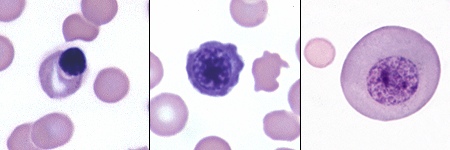The presence of nucleated cells of the erythroid line in peripheral blood
is an abnormal condition in the common mammalian species. This finding,
sometimes referred to as erythroblastosis, is noted most often
in dogs and cats in the context of strongly regenerative anemia. They can also be observed in llamas with regenerative anemias. In this
situation, the premature release of reticulocytes may be accompanied by
release of late-stage nucleated erythroid cells (metarubricytes, basophilic erythroblasts) as a peripheral blood manifestation of the effective erythroid
hyperplasia in marrow. They are seen less often in this setting in cattle
and horses; release of reticulocyes is less common in these species as well.
Erythroblastosis can also be seen in non-anemic animals with conditions
which compromise the effectiveness of the marrow's regulation of cell
release. These conditions include:
- Bone marrow injury from systemic sepsis or endotoxemia (this is most commonly observed in cats and llamas).
- Lead poisoning: A marked erythroblastosis with polychromasia in a non-anemic animal is a hallmark of lead poisoning in small animals. Basophilic stippling may also be seen but can be observed in these species with regenerative anemias.
- Acute myeloid leukemia and myelodysplasia: The cells in these conditions may be morphologically
abnormal, and provide a clue to the diagnosis. Animals are usually anemic in these conditions.
Miniature and Toy Poodles with hereditary macrocytosis may also have abnormal nRBCs in circulation. These dogs are not usually anemic.
- Abnormal splenic function: Increased nRBCs may be seen in dogs on corticosteroids, after splenectomy or dogs with hemangiosarcoma, especially in the spleen.
- Physiologic: Miniature Schnauzers and Daschunds can have small numbers of nRBCs in health.
|
